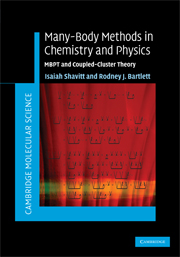Book contents
- Frontmatter
- Contents
- Preface
- 1 Introduction
- 2 Formal perturbation theory
- 3 Second quantization
- 4 Diagrammatic notation
- 5 Diagrammatic expansions for perturbation theory
- 6 Proof of the linked-diagram theorem
- 7 Computational aspects of MBPT
- 8 Open-shell and quasidegenerate perturbation theory
- 9 Foundations of coupled-cluster theory
- 10 Systematic derivation of the coupled-cluster equations
- 11 Calculation of properties in coupled-cluster theory
- 12 Additional aspects of coupled-cluster theory
- 13 The equation-of-motion coupled-cluster method for excited, ionized and electron-attached states
- 14 Multireference coupled-cluster methods
- References
- Author index
- Subject index
1 - Introduction
Published online by Cambridge University Press: 06 January 2010
- Frontmatter
- Contents
- Preface
- 1 Introduction
- 2 Formal perturbation theory
- 3 Second quantization
- 4 Diagrammatic notation
- 5 Diagrammatic expansions for perturbation theory
- 6 Proof of the linked-diagram theorem
- 7 Computational aspects of MBPT
- 8 Open-shell and quasidegenerate perturbation theory
- 9 Foundations of coupled-cluster theory
- 10 Systematic derivation of the coupled-cluster equations
- 11 Calculation of properties in coupled-cluster theory
- 12 Additional aspects of coupled-cluster theory
- 13 The equation-of-motion coupled-cluster method for excited, ionized and electron-attached states
- 14 Multireference coupled-cluster methods
- References
- Author index
- Subject index
Summary
Scope
The book focuses primarily on many-body (or better, many-electron) methods for electron correlation. These include Rayleigh–Schrödinger perturbation theory (RSPT), particularly in its diagrammatic representation (referred to as many-body perturbation theory, or MBPT), and coupled-cluster (CC) theory; their relationship to configuration interaction (CI) is included. Further extensions address properties other than the energy, and also excited states and multireference CC and MBPT methods.
The many-body algebraic and diagrammatic methods used in electronic structure theory have their origin in quantum field theory and in the study of nuclear matter and nuclear structure. The second-quantization formalism was first introduced in a treatment of quantized fields by Dirac (1927) and was extended to fermion systems by Jordan and Klein (1927) and by Jordan and Wigner (1928). This formalism is particularly useful in field theory, in scattering problems and in the study of infinite systems because it easily handles problems involving infinite, indefinite or variable numbers of particles. The diagrammatic approach was introduced into field theory by Feynman (1949a,b) and applied to many-body systems by Hugenholtz (1957) and by Goldstone (1957). Many-body perturbation theory and its linked-diagram formalism were first introduced by Brueckner and Levinson (1955) and by Brueckner (1955), and were formalized by Goldstone (1957). Other important contributions to the methodology, first in field theory and then in the theory of nuclear structure, are due to Dyson (1949a,b), Wick (1950), Hubbard (1957, 1958a,b) and Frantz and Mills (1960). Applications to the electronic structure of atoms and molecules began with the work of Kelly (1963, 1964a,b, 1968), and molecular applications using finite analytical basis sets appeared in the work of Bartlett and Silver (1974a, b).
- Type
- Chapter
- Information
- Many-Body Methods in Chemistry and PhysicsMBPT and Coupled-Cluster Theory, pp. 1 - 17Publisher: Cambridge University PressPrint publication year: 2009

